 Are you currently managing your own LinkedIn group?
Are you currently managing your own LinkedIn group?
Are you considering launching a LinkedIn group?
Keep reading for five tips on how to better manage LinkedIn groups.
Why Start a LinkedIn Group?
Building a LinkedIn group around a specific cause or niche topic can provide many business benefits. You could:
- Build more awareness with your target markets
- Position you and/or your company as an industry thought leader
- Nurture valuable industry relationships
- Showcase and highlight your own thought leadership content
- Generate interest and inquiries for your company
- Convert group members to subscribers and advocates for your brand
As you can see, there are many good reasons to start a LinkedIn group, but it can be very helpful to have some guidelines for managing a successful group after you launch.
https://www.youtube.com/watch?v=F5CF1FEm_oA&
If you're unsure about best practices for launching a successful LinkedIn group, you may want to revisit these Tips for Launching and Building a Thriving LinkedIn Group for the basics.
This article focuses primarily on helping you learn how to successfully manage a LinkedIn group.
Learning how to manage your own LinkedIn group effectively will also help you discover other well-managed LinkedIn groups to participate in. This can make all the difference in the world with regard to your experience.
5 Tips for Effectively Managing a LinkedIn Group
Currently I manage a LinkedIn group that has over 3200 members with hundreds of new requests to join each month. From this experience, I've learned some valuable lessons about how to manage a group effectively to keep members happy and make sure the group is free from spam and clutter!
#1: Review Your LinkedIn Group Name and Description
The name you give your group and the description you provide are critical to attracting the right members. You want to make sure that you use keywords in the title and description of your group, because these will show up in LinkedIn group searches. (They will also be indexed by Google.)
You have approximately 48 characters for your LinkedIn group “title” that will show up in LinkedIn group search results.
For your LinkedIn group description, use words to encourage potentially interested members to click-through and learn more about joining your group. This is an important differentiator for standing out from your competitors in the group search results.
As you will see in the image below, someone who finds this group via LinkedIn or Google search must apply to join. This creates the perception of exclusivity. It means that not everyone is let into the group.
Get World-Class Marketing Training — All Year Long!
Are you facing doubt, uncertainty, or overwhelm? The Social Media Marketing Society can help.
Each month, you’ll receive training from trusted marketing experts, covering everything from AI to organic social marketing. When you join, you’ll also get immediate access to:
- A library of 100+ marketing trainings
- A community of like-minded marketers
- Monthly online community meetups
- Relevant news and trends updates
Remember, people love to feel special.
For your group description, approximately the first 140 characters will show up in search results.
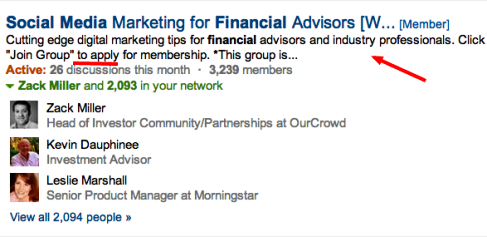
#2: Create a Strict Group Policy
LinkedIn allows group owners to craft a policy that contains the rules that they want the group to follow. It is important to create group rules that are both firm and clear. Do not assume that everyone will read your group rules.
The image below is a snapshot of my LinkedIn group policy. Notice that it is very specific and clear about what the expectations are.
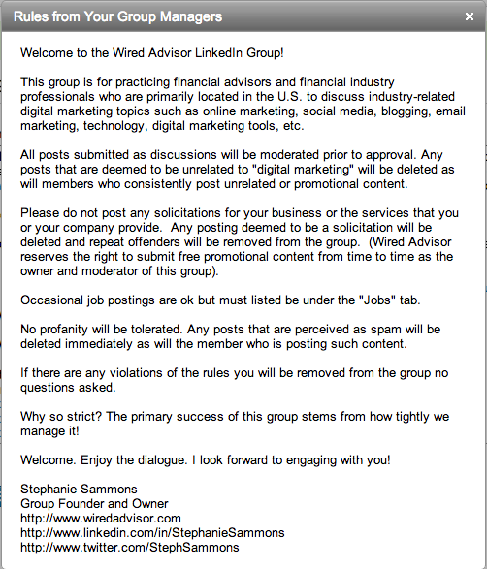
To ensure your group rules catch on and stick with members, you must reiterate them frequently and in multiple places.
For example, summarize your group rules in your initial LinkedIn group welcome message that goes out to new members.
Also consider posting and highlighting an occasional discussion as a reminder of what is acceptable in the group. Sending an announcement message to members reiterating your rules might also be necessary from time to time.
As you will see in the image below, I've had to be very firm in what is acceptable to post in my group.
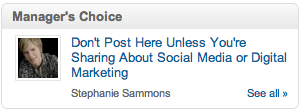
Members will appreciate and respect this and will likely share comments to confirm this. Don't be afraid to make a bold statement about your rules and highlight them as your Manager's Choice discussion.
No one appreciates spam, and LinkedIn groups that are poorly managed can be overtaken by spam, unfortunately.
#3: Screen New Members AND Member Discussion Posts
A big key to managing a successful group is to moderate who can get in as well as what can be posted.

Discover Proven Marketing Strategies and Tips
Want to go even deeper with your marketing? Check out the Social Media Marketing Podcast! Publishing weekly since 2012, the Social Media Marketing Podcast helps you navigate the constantly changing marketing jungle, with expert interviews from marketing pros.
But don’t let the name fool you. This show is about a lot more than just social media marketing. With over 600 episodes and millions of downloads each year, this show has been a trusted source for marketers for well over a decade.
As you can see from my group description in tip #1, you can choose to pre-approve every single new member. Pre-approving members who want to join your group does take time, but it is extremely important if you want to build a quality group!
Here are some quick tips to decide who can join your LinkedIn group:
- Make sure they have a picture on their LinkedIn profile.
- Make sure they fit your specific criteria for group membership (i.e., location, job description, etc.).
- Make sure they have been a LinkedIn member for at least 30 days (LinkedIn will alert you to brand-new members).
In order to help with this process, take advantage of LinkedIn's automated email templates (see image below) to clearly explain your process for granting admission to the group, as well as your expectations of group members.
You can use LinkedIn email templates to send a pre-written message to those who have requested to join and are awaiting approval and those to whom you decline membership.
You can also send a pre-written welcome message to new members who have been approved.
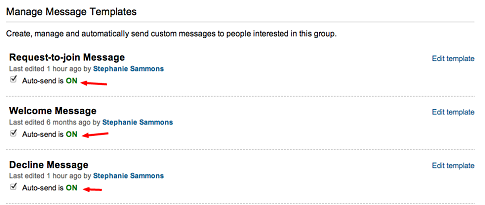
Should you moderate group discussion posts?
Moderating what gets posted to your group can also be effective to maintain quality and keep the group on topic. If you choose not to pre-approve discussions before they are posted to the group, you will want to monitor the posted discussions closely to make sure they are aligned with your policy.
If a member continues to post content that you deem to be non-relevant or overly promotional, you can either send them a warning or remove them from your group altogether, depending on what your group rules state.
Should you allow your direct competitors to post in your LinkedIn group?
Be careful about this. There may be some benefit to working with a competitor who has a related, well-managed LinkedIn group. However, be aware of those who are more interested in gaining exposure to the members of your group for marketing purposes rather than the well-being of your group!
#4: Use the Group Announcements Feature
With the LinkedIn Group Announcements feature, you can send up to one announcement per week directly to the email inboxes of your members.
This is a great opportunity to share helpful content and encourage members to subscribe to your blog, invite them to attend a webinar or download a free guide that you've put together.
The key to running a successful campaign using the group announcements feature is to craft a compelling subject line. The email will actually come from LinkedIn, and many of us receive numerous emails from LinkedIn each day. Therefore you will need a great headline to make your group announcement stand out.
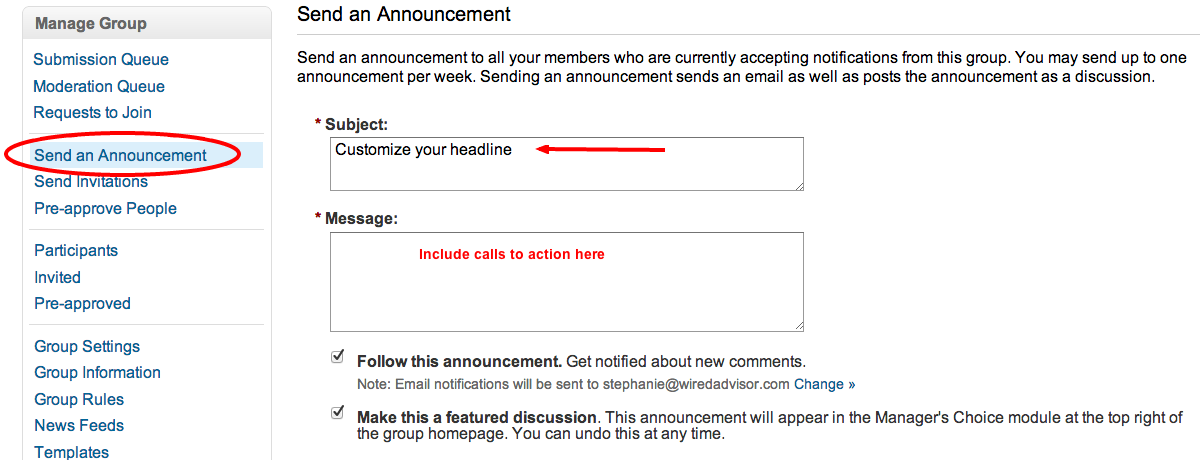
Additionally, be careful about abusing this privilege as many group owners do. Mix up your messages and don't send a call to action every time. Consider alternating between value messages that are helpful or informative and specific calls to action.
#5: Lead Your Group
Of the five tips, this is the most important. Someone needs to actually lead the group. If you represent a big brand or larger company, choose a spokesperson who can be the face of the group and spend time being involved in the group.
If you're a small business owner, you should be the face of your group.
How can you lead your LinkedIn group?
Lead your group by becoming one of its most active members. By being active in your own group and positioning yourself as the leader of your group, members will get to know and trust you. Do not expect your group to lead itself.
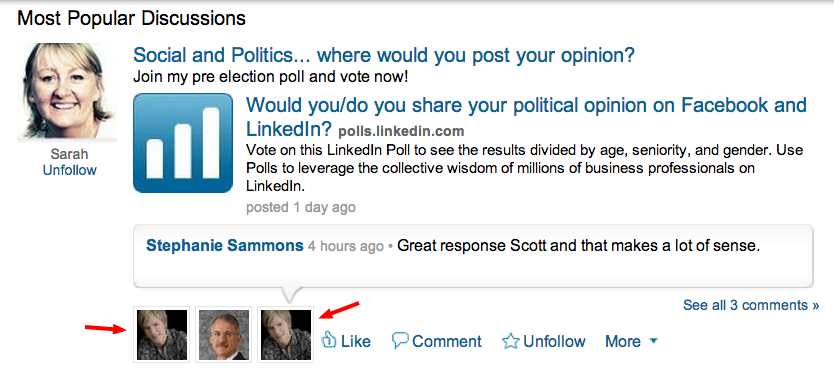
Here are some recommendations for how you can lead your group:
- Post a weekly discussion—share your own thought leadership insights as well as valuable content that you discover online.
- Post a weekly question.
- Comment on existing discussions (this will almost always create activity).
- Encourage engagement through questions and feedback requests.
- Run LinkedIn Polls within your group.
LinkedIn group activity does go out to members in a weekly email digest. The more interesting and relevant the discussions are in your group, the more likely your members will be to open that email and get engaged.
If you follow these LinkedIn group management tips, you will build and grow a very high-quality group. It will require a commitment from you or a team member to stay on top of managing the group on a weekly or daily basis, but the outcome will be very rewarding!
Your members will also appreciate the quality of your group, and they won't be hesitant to share your group with friends, colleagues and connections.
What challenges are you experiencing with managing a LinkedIn group? Do you see ways that you can improve existing groups? Are you thinking about starting your own LinkedIn group? Share your thoughts with me below.
Attention Agency Owners, Brand Marketers, and Consultants

Introducing the Marketing Agency Show–our newest podcast designed to explore the struggles of agency marketers.
Join show host and agency owner, Brooke Sellas, as she interviews agency marketers and digs deep into their biggest challenges. Explore topics like navigating rough economic times, leveraging AI, service diversification, client acquisition, and much more.
Just pull up your favorite podcast app, search for Marketing Agency Show and start listening. Or click the button below for more information.

